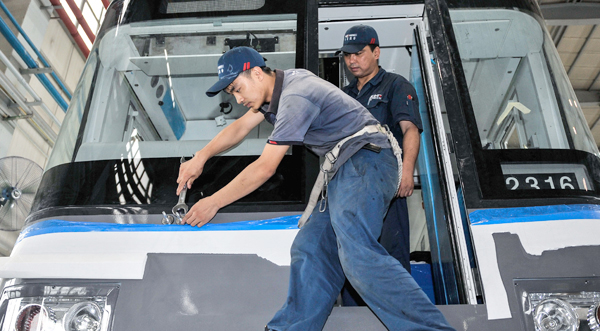China-focused firm invests in Ottawa-area commuter rail plan
BILL CURRY
OTTAWA — The Globe and Mail
PublishedSunday, Jul. 16, 2017 8:11PM EDT
Last updatedSunday, Jul. 16, 2017 8:42PM EDT
A Toronto-based condo developer that specializes in attracting Chinese capital for Canadian real estate is investing in a controversial proposal for a privately run commuter rail network throughout the National Capital Region.
Toronto’s LeMine Investment Group – which has developed condos in Toronto and Ajax – has agreed to spend $5-million on a 120-day study of the merits of a proposed 400-kilometre regional rail network that would connect several small communities outside Ottawa and Gatineau to the downtown core.
In an interview, LeMine chief executive officer Thomas Liu said what impressed him about the project is that it would provide supporting infrastructure that would benefit the public and be financed through the rising property values that would result from putting trains stations in outlying communities.
“It’s a perfect combination,” he said. “That’s what’s amazing about this project.”
Mr. Liu has described his company as having a mandate to be the international investment platform for Chinese capital. Moose Consortium Inc. – the group behind the rail plan – expects major international capital will follow if the study goes well.
Mr. Liu’s name came up on the floor of the House of Commons in November, when the NDP raised his attendance at a small $1,500 Liberal Party fundraiser in Toronto to meet with Prime Minister Justin Trudeau. The questions were in the context of the cash-for-access controversy that led the Liberals to introduce reforms for campaign fundraising. Mr. Liu declined to discuss the fundraiser in an interview two weeks ago.
Mr. Trudeau and his government are actively encouraging large-scale foreign investment in Canadian infrastructure.
Moose has been promoting its regional commuter rail idea for several years without any clear sign of traction until now. The first partner companies invested about $500,000 before the deal with LeMine Investment Group. The new partnership also involves a company called Consortia NA, which facilitates private infrastructure projects.
Joseph Potvin, the director-general of Moose, says that if the study is positive, LeMine would at least double that amount for further analysis. Ultimately, the project envisions a $500-million private investment to establish the network, which would use refurbished existing rail lines.
The Moose team says other international investors are prepared to support the project if the initial study is positive. The study is being conducted by Opus International Consultants and Remisz Consulting Engineers Ltd.
The proponents are asking the federal government to endorse the plan, but are not seeking any public money.
The business case is built on capitalizing on the increase in property values that would result from new commuter rail service.
Because the project would cross an interprovincial bridge, Moose says a rarely used section of the Constitution would exempt it from provincial regulation, meaning it would need only federal approval to go ahead.
The plan includes six rail lines that all meet just west of downtown Ottawa at the Prince of Wales Bridge, which opened in 1881 and is not currently in use. On the Ontario side, a western line would run to Arnprior, a southern line would reach Smith Falls and an eastern line would go to Alexandria. On the Quebec side, the plan would serve Bristol to the west, Wakefield to the north and Montebello to the east. All lines would have other stops along the way.
The lines extend much further than the City of Ottawa’s existing plans for a light rail network. The Moose network would primarily serve people who live outside the City of Ottawa.
The project faces many hurdles, including the fact that Ottawa Mayor Jim Watson does not appear to be interested.
“Mayor Watson has not seen or been made aware of a viable proposal from Moose,” said Livia Belcea, the mayor’s spokesperson. Moose appears to have irritated City of Ottawa officials by asking the Canadian Transportation Agency to rule that the city was wrong to remove some track leading up to the Prince of Wales Bridge.
“The [Moose] consortium appears to have no running stock, financing or any of the other indicia of a rail company,” City of Ottawa solicitor Rick O’Connor wrote in a terse e-mail to council members on June 28 in relation to the dispute. The e-mail was sent before Moose secured the LeMine financing.
Mr. Liu, the LeMine CEO, said he would expect the project would begin with two or three stations to demonstrate how the business model would work.
“I see this project as a long-term project,” he said. “I don’t think we are able to develop all of these [communities] within even the next 10 years.”
Liberal MP Greg Fergus, who represents the Quebec riding of Hull-Aylmer across the river from Parliament Hill, said the new investor interest is “exciting” news that changes the way Moose’s proposal should be perceived.
“At a half million dollars, it might not be very credible. At $5-million, it’s all of a sudden a lot more credible,” he said. “And if the market studies that are funded by the private sector come out and say, ‘Yes, this is well worth doing,’ and they’re willing to bankroll several hundred million dollars, then the credibility is already there.”
While some critics of the MOOSE project say it would encourage urban sprawl, Mr. Fergus said it can be good for the environment if people live in densely built suburbs with commuter rail within walking distance.
“It brings so many good things from a health perspective, from an economic perspective,” he said.
Mr. Fergus said behind-the-scenes talks are progressing about linking the City of Ottawa and Gatineau transit systems by rail, likely over the Prince of Wales Bridge, which the city owns, but those discussions have not included talk of Moose’s proposal.
“I think all these projects can live together,” he said. “The wonderful thing about trains is you can schedule them.”









